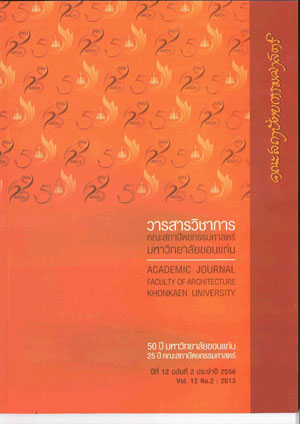แนวคิดการออกแบบโดยคำนึงถึงสภาวะคณะแวดล้อมในอาคารพิทยอนันต์ โรงเรียนสาธิตมหาวิทยาลัยขอนแก่น คณะศึกษาศาสตร์ จังหวัดขอนแก่น
คำสำคัญ:
อาคารพิทยอนันต์, การออกแบบและวางผัง, การออกแบบโดยคำนึงถึงสภาพแวดล้อม, Pittaya Anant Building, Design and Planning, Environmental-Conscioused Designบทคัดย่อ
“อาคารพิทยอนันต์” เป็นอาคารเรียนรวมของโรงเรียนสาธิตมหาวิทยาลัยขอนแก่น (ศึกษาศาสตร์) เกิดจากความต้องการทดแทนพื้นที่อาคารเดิมของโรงเรียนที่มีความทรุดโทรม อันเนื่องมาจากอายุการใช้งานมากกว่าสามสิบปี ในการจัดการพื้นที่ใช้สอยของอาคารพิทยอนันต์ นั้น นอกจากเพื่อการเรียนการสอนแล้วยังต้องรองรับกิจกรรมสารสนเทศและนวัตกรรมการสอน ในระดับการศึกษาขั้นพื้นฐาน อันเป็นหน้าที่ตามวัตถุประสงค์ของโรงเรียนสาธิตมหาวิทยาลัย ขอนแก่น
บทความนี้ นำเสนอแนวคิดการออกแบบ “อาคารพิทยอนันต์” ในแง่มุมการออกแบบ ทางกายภาพที่คำนึงถึงสภาวะแวดล้อมและการตอบสนองกับสภาพภูมิอากาศท้องถิ่นเพื่อรองรับ ต่อกิจกรรมที่มีความหลากหลายดังกล่าวทั้งภายในอาคารและพื้นที่โดยรอบอาคาร โดยหวังว่าทั้ง ผลสำเร็จและความผิดพลาดอันเกิดจากการออกแบบจะนำไปสู่ข้อพิจารณาสำหรับการออกแบบ อาคารในลักษณะ ประเภท และขนาด ที่ใกล้เคียงกันต่อไป
An Environmental Conscious Design Concept in the Pittaya Anant Building Demonstration School, Faculty of Education, Khon Kaen University, Khonkaen Province
Artt Chamarek
Pittaya Anant Building is a common lecture facility within Khon Kaen University Demonstration School. It is a replacement for existing buildings that had been used for over thirty years. The utilization of Pittaya Anant Building extends beyond general learning & teaching into supporting activities on information and learning innovations for fundamental pedagogy that is one of the school›s key objectives. Such versatile activities both within the building and on surrounding grounds call for complex design concepts that negotiate well with functional utilization as well as environmental issues. This article presents the design concepts for Pittaya Anant Building from the perspective of physical design with environmental concerns and local climate response. Its conclusion highlights various degree of achievement that may lead to further design consideration for similar building typologies.
ดาวน์โหลด
รูปแบบการอ้างอิง
ฉบับ
ประเภทบทความ
สัญญาอนุญาต
ทัศนะและข้อคิดเห็นของบทความที่ปรากฏในวารสารฉบับนี้เป็นของผู้เขียนแต่ละท่าน ไม่ถือว่าเป็นทัศนะและความรับผิดชอบของกองบรรณาธิการ




